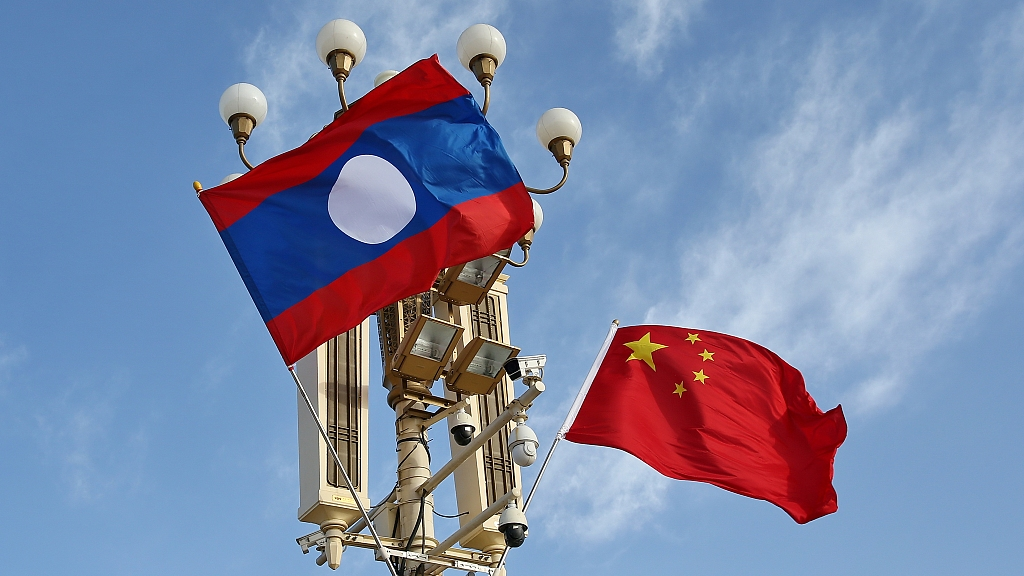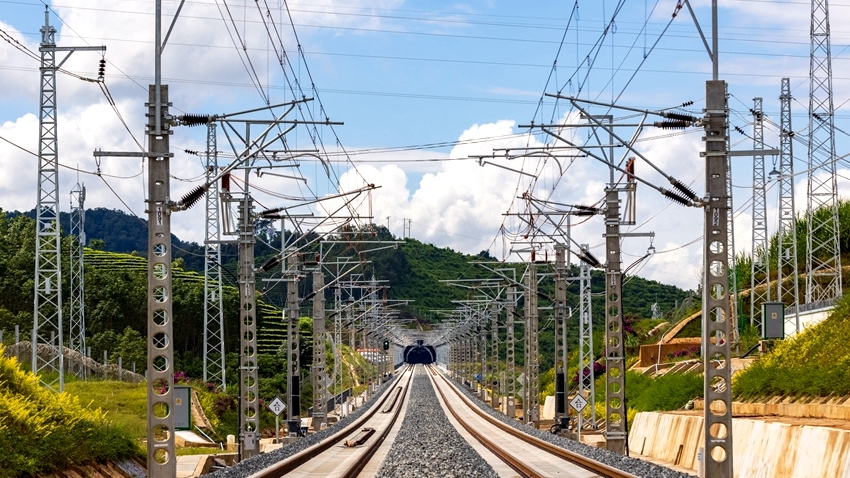
The national flags of China and the Laos at Tian'anmen Square, Beijing, China, November 29, 2022. /VCG
The national flags of China and the Laos at Tian'anmen Square, Beijing, China, November 29, 2022. /VCG
Editor's note: Ji Xianbai is an associate professor at the School of International Studies, Renmin University of China. He is also co-editor of "From Centralised to Decentralising Global Economic Architecture: The Asian Perspective" (Palgrave Macmillan, 2022). The article reflects the author's opinions and not necessarily the views of CGTN.
Following his Vietnamese and Cuban counterparts, Lao President Thongloun Sisoulith has arrived in Beijing for a state visit, coming as a one-year mark since the launch of the China-Laos Railway.
Running between the capital Vientiane and the town of Boten on the Laos-China border and extending northward to Kunming, China, the electrified high-speed railway had transported 1.8 million tons of goods worth over 12 billion yuan ($1.7 billion) over the past eleven months despite disruptions caused by the ongoing COVID-19 pandemic.
Along with facilitating bilateral trade between China and Laos, the railway plays an instrumental role in promoting regional development and interconnected economic growth.
For decades, Laos has been a closed economy in geographical and policy terms. It is landlocked by China to the north, Myanmar to the west, Thailand and Cambodia to the South and Vietnam to the east. Yet, it has gradually abandoned autarkic economic policies from the 1980s.
The geographic closeness may have played a part in hindering Lao's economic takeoff. Poverty declined while the country remained largely agrarian in its economic structure and source of employment.
Policy recommendations for diversifying into labor-intensive manufacturing sectors and boosting resource exports beyond copper had been prescribed by multilateral development institutions and bilateral creditors alike and yet weak public revenue stream and low domestic saving rates had strained Vientiane's ability to overcome its hard and soft challenges.
The economic ascendancy of China and the emergence of the Belt and Road Initiative (BRI) – of which the railway is a part – have brought renewed and unprecedented opportunities to the least industrialized, infrastructure-poor country in Southeast Asia suffering from international economic isolation.
The China-Laos Railway is transforming Laos from a landlocked state into a land-linked hub at the heart of mainland Southeast Asia, an inland interchange where commercial and people flows from China, Myanmar, Thailand, Cambodia and Vietnam mingle to bolster new investment opportunities and business partnerships.
Laos' participation in the Regional Comprehensive Economic Partnership (RCEP) – the word's largest free trade area – is praiseworthy as well. By subjecting to a pro-market, rules-based regional economic order embodied in and cemented by the RCEP, Laos has shown a commitment to economic openness and cooperative international economic relations.

A section of the China-Laos Railway in Xishuangbanna Dai Autonomous Prefecture, Yunnan Province, China, September 28, 2021. /Xinhua
A section of the China-Laos Railway in Xishuangbanna Dai Autonomous Prefecture, Yunnan Province, China, September 28, 2021. /Xinhua
The cumulative rules of origin of the RCEP – on top of enhanced rail connectivity afforded by the China-Laos Railway – allows Laos to more fully engage itself in flourishing regional supply chains and production sharing networks, thus unwinding the historical pattern emerged since the late 1960s that only maritime and coastal parts of Southeast Asia take part in industrial catch-up and economic modernization processes. With the railway and RCEP upgrading its physical and policy connectivity respectively, Laos has never been in a better position to integrate into regional supply chains.
The next step should be stretching the China-Laos Railway further south to Thailand and even to Singapore (in part in accordance with the pan-Asian railway network plan) so as to form the real backbone of the China-Indochina Peninsula economic corridor, also part of the comprehensive blueprint of the BRI.
Meanwhile, to unleash greater economic potential of the existing China-Laos Railway, the emphasis could be placed on synchronizing Laos' industrialization and urbanization strategies with the railway. Developing a few industrial parks, special economic zones, cross-border free trade zones, dry ports, export processing zones, integrated logistics facilities as well as urban and residential centers along the railway could go a long way in stimulating economic and industrial development of Laos.
The tangible and forthcoming developmental impact of the China-Laos Railway is emblematic of what differentiates BRI (and the latest formulation of the Global Development Initiative) from the United States' belligerent Indo-Pacific Economic Framework, with the latter being primarily fixated on containing China's influence without offering proportional economic benefits to regional countries eager for development assistance.
Accordingly, President Sisoulith's well-timed visit to China elevates China-Laos bilateral relations to a new height and helps public regional and developing countries to achieve economic development and harmonious international relations in the region. May the friendship between the two countries moves forward just as the galloping electrified passenger and freight trains running on the tracks of the China-Laos Railway!
(If you want to contribute and have specific expertise, please contact us at opinions@cgtn.com. Follow @thouse_opinions on Twitter to discover the latest commentaries on CGTN Opinion Section.)